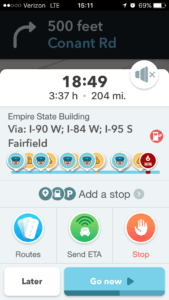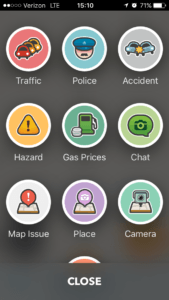Waze: Traffic from the Crowd

Waze promises more reliable traffic information using active and passive driver inputs.
What is Waze?
Waze is a map and traffic app that relies on users to provide data that allows for a more accurate traffic picture. All traffic apps make use of active GPS data to provide the app with more accurate information about current traffic conditions, to improve ETAs and routing.[1] In this regard, though Waze is leveraging passive user data, it is not particularly innovative. However, Waze takes it a step further. It also relies on users to source information about traffic conditions, road conditions, hazards, police/speed camera locations, and many other traffic-related inputs.[2] Thus, Waze is creating value over and above other traffic apps through active user participation in providing information about road conditions.
(L) Sample pre-drive report, showing ETA, hazards, and speed traps. (R) Waze traffic condition input interface
One reason that this is so valuable is that road conditions are by definition fluid. Traffic changes, of course, but so do the location of speed traps. Potholes are fixed. Cars stopped alongside the highway may move. There is lots of information that is relevant to the driver that is important if accurate, but also difficult to pin down. Waze has approached this problem with a crowd-sourcing model, and has arrived at a pretty effective solution.
A pitfall of Waze’s model is that in order to drive incremental value above competitors, it is extremely reliant on engaged and reliable users. Without active usage, the crowd-sourcing of road conditions falls apart and it becomes merely another GPS traffic app. Waze’s approach to this problem has been gamification. It rewards users at a baseline level for passive usage, while providing incremental rewards for active reporting. These rewards are reputational – as users earn more points, their rank and avatar “level up” reflecting their tenure and engagement with the platform. Waze also provides bonus points for certain milestones – e.g., number of friends on the app, map problems reported, being a top user, and others. Through these methods, Waze has relied on gamification to incentivize active usage in addition to good citizenship as part of the community.
Waze User Profile
Challenges and Crowd Management
This model is not without its challenges. One key challenge is accuracy – the app is only as good as the reliability of its data. And because the events underlying the data (e.g., accidents) are always in flux, Waze needs to make sure that it has a constant stream of users updating data, so it knows when a road hazard has been resolved and can be removed from the app. This problem is compounded if users are not providing accurate information, and if users are freeloading on the app. For example, Waze needs to know if a user drove by a speed trap and didn’t report it because the speed trap moved, or because the user just wasn’t providing information. These reliability problems compound each other, but are critical to the success of the model.
A second, acute challenge Waze faces is around safety. Waze gained significant negative publicity when the app was purportedly used to locate two police officers killed in a shooting.[3] This event gave it a very negative reputation within the police community, a reputation already tenuous due to the conflict of interest between police departments and drivers regarding the location of speed traps.[4] Also potentially seriously, Waze relies on drivers to supply road information, but the reporting method of tapping multiple times on a phone screen while driving at 65 MPH raises significant questions about safety and driver distraction.[5] Thus, while so far the app has been very successful, safety and the relationship with the law enforcement community are key challenges for Waze going forward.
Value Capture and Growth Potential
Waze captures value through advertisements. It was privately held, then sold to Google, so it is unknown how commercially successful the app is today. However, there are two factors worth highlighting. First, the target audience is engaged in driving, raising doubts about how receptive they could be to advertising, unless Waze can successfully drive incremental drivers to gas stations or fast food stops.[6] Second, however, because it is a crowd-sourced app, it is logical to assume that its users are more engaged than average map users. These two factors would drive disparate conclusions about Waze’s ability to drive app revenue. However, in this author’s opinion, it is unlikely that Waze is capturing value in proportion to its value creation. However, should it find innovative ways to capture value, that will significantly boost its growth potential, and Waze surely must have a large untapped audience of potential users currently using other traffic apps.
[1] http://www.npr.org/sections/alltechconsidered/2015/05/18/407658702/the-tech-behind-traffic-apps-how-well-do-they-work
[2] http://autoweek.com/article/car-life/free-waze-app-uses-crowdsourcing-help-drivers-avoid-traffic
[3] http://www.hngn.com/articles/54097/20141228/waze-app-used-by-nypd-cop-killer-prior-to-shooting.htm
[4] http://www.businessinsider.com/police-officers-vs-waze-google-traffic-crowdsourcing-app-2015-2
[5] http://www.michiganautolaw.com/blog/2015/07/16/waze/
[6] https://digiday.com/media/waze-advertisers/






Thanks for a great post. I agree with you that Waze has a strong, loyal user base, which could be very interesting to potential advertisers. I also think it is a great example of a crowdsourcing platform that grew its user base organically, just by improving its users’ lives. To me, Google’s purchase of the app puts its future into question, especially since we see Google investing so much in its own Maps app. I wonder if Google sees purchasing Waze as a way to use crowdsourcing data to improve its own Maps functionality, or if it is trying to own the competition?